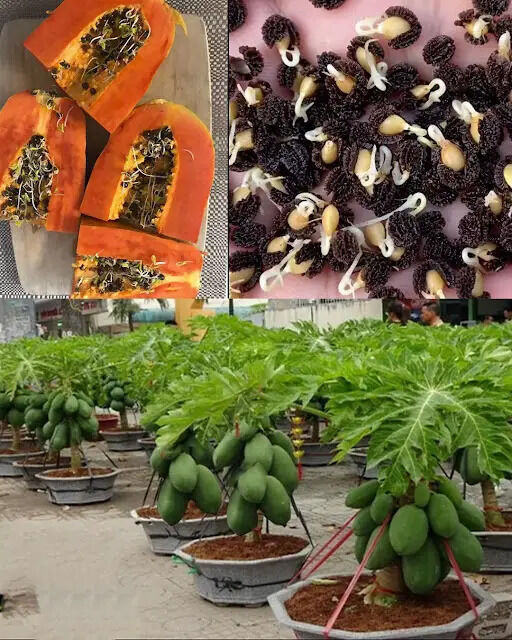ADVERTISEMENT
**Grow Papaya at Home in Pots: The Secret for an Abundant Harvest**
Imagine stepping outside into your garden and plucking a ripe, sweet papaya straight from the plant. Growing your own papaya at home is not only possible but can be incredibly rewarding—especially when you’re limited on space. With a little care and the right knowledge, you can grow papayas in pots and enjoy a bountiful harvest right in your backyard (or even on a balcony!). Here’s how you can make it happen.
### Why Grow Papaya in Pots?
Papayas are tropical fruits that thrive in warm, sunny climates, making them perfect for container gardening. Growing papaya in pots is ideal for people who don’t have a large garden or who live in areas where the ground might not be suitable for planting tropical trees. Pots also give you the flexibility to move the plant around to ensure it gets the right amount of sun, and they provide better control over the soil quality.
The best part? Growing papayas in pots isn’t just for people in tropical or subtropical regions. As long as you can provide warmth, plenty of sunlight, and the right growing conditions, you can successfully grow papayas in pots even in more temperate climates.
### Choosing the Right Papaya Variety for Pots
Not all papayas are the same, and some varieties are better suited to container growing than others. When selecting a papaya tree for your pot, look for a dwarf or compact variety that’s specifically bred for container gardening. Varieties like **‘Red Lady’** and **‘Solo’** are good choices, as they are smaller in size but still produce delicious fruit.
It’s important to note that papayas are generally male, female, or hermaphrodite, and you need at least one hermaphrodite or a combination of male and female plants to ensure pollination. If you’re growing multiple plants, be sure to select one or more hermaphrodite papayas, as they can produce fruit on their own.
### Step-by-Step Guide to Growing Papaya in Pots
1. **Choose the Right Pot**
Papayas need plenty of space to grow their roots, so select a large, sturdy pot with good drainage. A 5-gallon pot is a good starting point for a young plant, but larger containers (10–15 gallons) will be needed as the tree matures. Ensure the pot has drainage holes to avoid waterlogging.
2. **Pick the Right Soil**
Papayas love well-draining, loamy soil. You can either buy a pre-mixed potting soil designed for tropical plants or make your own by combining regular potting soil with perlite or sand to improve drainage. If you’re using heavy soil, amend it with organic compost to help improve fertility.
3. **Planting Your Papaya Seedling**
You can start papayas from seeds, but it’s often quicker and easier to buy a young plant from a nursery. When planting, dig a hole that’s just big enough for the root ball, and gently place the plant in the pot. Make sure the top of the root ball is level with the surrounding soil to avoid burying the stem too deeply.
4. **Provide Ample Sunlight**
Papayas are sun-loving plants, so make sure your pot is placed in a spot that gets plenty of bright sunlight—ideally, 6 to 8 hours a day. A south-facing patio, balcony, or garden area is often perfect. If you live in a region with cold winters, consider moving your papaya indoors or using a greenhouse during the colder months.
5. **Watering**
Papayas need consistent moisture, but they don’t like to sit in water. Water your plant regularly, especially during dry spells, but be sure the pot drains well. Check the soil moisture before watering; the soil should be moist but not soggy. During the growing season, water more frequently, and reduce watering during the dormant months (fall and winter).
6. **Fertilize Regularly**
To encourage healthy growth and fruiting, papayas need regular feeding. Use a balanced fertilizer, preferably one that’s high in nitrogen during the growing season to promote leaf growth. When the plant starts producing fruit, switch to a fertilizer that’s higher in potassium and phosphorus to support fruit development. Organic compost can also be used to enrich the soil.
7. **Prune and Support Your Plant**
Papayas don’t require much pruning, but you can remove dead or damaged leaves to keep the plant healthy. As papayas grow tall, they may need some support to prevent them from toppling over in the wind. Use a stake or trellis to support the stem if necessary, especially if you’re growing a taller variety.
For Complete Cooking STEPS Please Head On Over To Next Page Or Open button (>) and don’t forget to SHARE with your Facebook friends
ADVERTISEMENT
